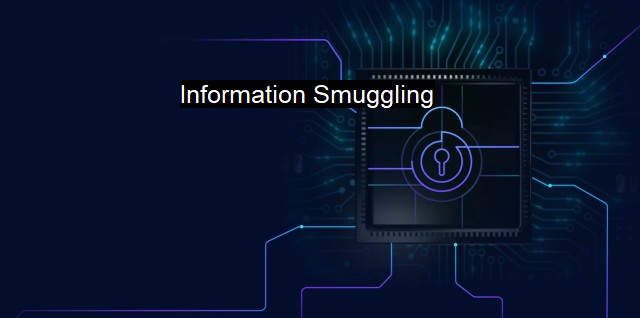What is Information Smuggling?
Uncovering the Threat of Information Smuggling: Understanding the Risks and Impact on Cybersecurity and Antivirus Tools
"Information Smuggling," refers to a significant and emerging threat that organizations globally are continually facing. This threat exposes organizations to serious security-related complications arising from the unintended or unauthorized transportation of data across a network or a system. Proponents of "Information Smugglings" are hackers and malicious actors who prudently utilize available and emerging technologies to infiltrate systems and exfiltrate data stealthily.The process of information smuggling principally involves bundling of data or information in a way that it can bypass security checkpoints without any prohibitions, often embedded into legitimate network traffic. This clandestine method can mislead the firewalls, security detectors by manipulating accepted protocols and concealing malicious requests inside valid flow of data.
The smuggled information may encompass a variety of things ranging from sensitive personal or organizational data to financial data. It could also include important government intelligence information or proprietary trade secrets. This insurgent exchange of data flows beneath the cybersecurity radar, which ionizes a wide range of rules in the lesser-visited regions of cyber protocols. Information smuggling edges on the periphery of cyber-espionage and cyber-terrorism, compromising nations, businesses, and individuals' security.
Typically, cyber threat actors, motivated by financial profits, political draughts, or strategic intermediations, carry out these covert operations. These attacker narratives precisely detail how information smuggling has now become a go-to strategy for every 'sophisticated advisory' in today's era. Apart from inflicting direct harm, these attacks, when eminent, may dilapidate the trust among clients, partners and employees, thereby posing grave reputational risks to corporate bodies.
A particularly challenging aspect of this nefarious activity is its sophistication and 'low-profile' nature, circumventing existing traditional detection methods often. Hackers employ various technologies such as 'Fast-Flux,' 'DDoS attacks,' 'Domain Generation Algorithm'' and 'HTTP Tunneling' to smuggle information through seemingly innocuous channels, overwhelming conventional cybersecurity solutions. With the aid of these advanced tactics, hackers triumphantly transcend the tiers of security detection, effectively neutralizing organizations' cyber defenses.
The cybersecurity ecosystem needs advanced strategies and solutions to tackle the complex landscape of Information Smuggling. Many solutions such as artificial intelligence (AI), machine learning (ML), and network analytics can furnish cybersecurity mechanisms with deep visibility into network traffic and behavior. These technologies enable organizations to spot suspicious activities and proactively counter security threats, thus augmenting human-led countermeasures.
Artificial intelligence aids in predictive analytics by drawing out algorithms that can foresee probable security threats, while machine learning uses proficiencies attained from fed data to effectively decide and decipher the authenticity of freshly compiled requests or orders. Network analytics, on the other hand, scrutinizes network traffic patterns to introspect anomalies and nip them off at the bud.
Embedded cryptography, tokenization, or Key Management Systems (KMS) safeguard any data residing within an organizational network, whereas Endpoint Detection and Response (EDR) systems offer round-the-clock automated monitoring and alerts to ensure impenetrable defenses against information smuggling plots. Incorporating these technologies into organizations’ strategic vision can address this unaddressed peril systematically and structurally.
Addendum to this, corporate organizations must cultivate an intractable 'security-first culture' in their operating models, where data protection is esteemed over information mobility. Regular training should be instituted to keep the respective workforce informed about the security risks and prepared for unforeseen threats. For antivirus and cybersecurity programmers, continuous vigilance, research, and development will be the linchpin to counter this rising trend.
‘Information Smuggling’ stands as a potent adversary to the modern cyber-world. With more interconnected systems and voluminous data surges, the augmented risks of information smuggling are inevitable. Therefore, an advanced, robust approach toward cybersecurity, employing cutting-edge technologies and implementing professional awareness, can sustain businesses in the face of such challenging, evolving threats. Antivirus and cybersecurity companies have to continuously adapt to the changing tactics of information smugglers with timely, new-age solutions that can neutralize threats and defend the underlying infrastructures.

Information Smuggling FAQs
What is information smuggling?
Information smuggling refers to the practice of hiding or obfuscating sensitive or malicious data within seemingly innocuous files or applications in order to evade detection by antivirus or other security measuresWhy is information smuggling a concern in cybersecurity?
Information smuggling can be used to deliver malware or other harmful content, making it a threat to the security of computer systems and networks. Because smuggled information can be difficult to detect and may masquerade as harmless data or legitimate software, it can be used to bypass antivirus, firewalls, and other security measures.What are some common techniques used in information smuggling?
Some common techniques used in information smuggling include steganography, which involves hiding data within other data (such as concealing a message within an image file), and packing, which involves compressing or encrypting files to obscure their contents. Other techniques include using multiple layers of obfuscation or hiding data in low-priority areas of a file or system.How can organizations protect themselves against information smuggling?
Organizations can protect themselves against information smuggling by implementing robust antivirus and antimalware solutions, regularly updating software and security patches, and educating employees on safe computing practices. Additional measures may include using intrusion detection and prevention systems, monitoring network traffic for suspicious activity, and implementing network segmentation to limit the impact of any potential security breaches.| | A | | | B | | | C | | | D | | | E | | | F | | | G | | | H | | | I | | | J | | | K | | | L | | | M | |
| | N | | | O | | | P | | | Q | | | R | | | S | | | T | | | U | | | V | | | W | | | X | | | Y | | | Z | |
| | 1 | | | 2 | | | 3 | | | 4 | | | 7 | | | 8 | | |||||||